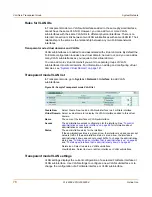
72
01-28008-0013-20050204
Fortinet Inc.
VLANs in NAT/Route mode
System Network
In NAT/Route mode, the FortiGate units support VLANs for constructing VLAN trunks
between an IEEE 802.1Q-compliant switch (or router) and the FortiGate unit. Normally
the FortiGate unit internal interface connects to a VLAN trunk on an internal switch,
and the external interface connects to an upstream Internet router untagged. The
FortiGate unit can then apply different policies for traffic on each VLAN that connects
to the internal interface.
In this configuration, you add VLAN subinterfaces to the FortiGate internal interface
that have VLAN IDs that match the VLAN IDs of packets in the VLAN trunk. The
FortiGate unit directs packets with VLAN IDs, to subinterfaces with matching VLAN
IDs.
You can also define VLAN subinterfaces on all FortiGate interfaces. The FortiGate
unit can add VLAN tags to packets leaving a VLAN subinterface or remove VLAN tags
from incoming packets and add a different VLAN tags to outgoing packets.
Rules for VLAN IDs
In NAT/Route mode, two VLAN subinterfaces added to the same physical interface
cannot have the same VLAN ID. However, you can add two or more VLAN
subinterfaces with the same VLAN IDs to different physical interfaces. There is no
internal connection or link between two VLAN subinterfaces with same VLAN ID. Their
relationship is the same as the relationship between any two FortiGate network
interfaces.
Rules for VLAN IP addresses
IP addresses of all FortiGate interfaces cannot overlap. That is, the IP addresses of all
interfaces must be on different subnets. This rule applies to both physical interfaces
and to VLAN subinterfaces.
Figure 21
shows a simplified NAT/Route mode VLAN configuration. In this example,
FortiGate internal interface connects to a VLAN switch using an 802.1Q trunk and is
configured with two VLAN subinterfaces (VLAN 100 and VLAN 200). The external
interface connects to the Internet. The external interface is not configured with VLAN
subinterfaces.
When the VLAN switch receives packets from VLAN 100 and VLAN 200, it applies
VLAN tags and forwards the packets to local ports and across the trunk to the
FortiGate unit. The FortiGate unit is configured with policies that allow traffic to flow
between the VLANs and from the VLANs to the external network.
Note:
If you are unable to change your existing configurations to prevent IP overlap, enter the
CLI command
config system global
and
set ip-overlap enable
to allow IP address
overlap. If you enter this command, multiple VLAN interfaces can have an IP address that is
part of a subnet used by another interface. This command is recommended for advanced users
only.
Summary of Contents for FortiGate FortiGate-5020
Page 86: ...86 01 28008 0013 20050204 Fortinet Inc Dynamic IP System DHCP ...
Page 118: ...118 01 28008 0013 20050204 Fortinet Inc FortiManager System Config ...
Page 254: ...254 01 28008 0013 20050204 Fortinet Inc CLI configuration User ...
Page 318: ...318 01 28008 0013 20050204 Fortinet Inc CLI configuration Antivirus ...
Page 350: ...350 01 28008 0013 20050204 Fortinet Inc Using Perl regular expressions Spam filter ...
Page 370: ...370 01 28008 0013 20050204 Fortinet Inc CLI configuration Log Report ...
Page 382: ...382 01 28008 0013 20050204 Fortinet Inc Glossary ...
Page 402: ...402 01 28008 0013 20050204 Fortinet Inc Index ...



































